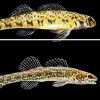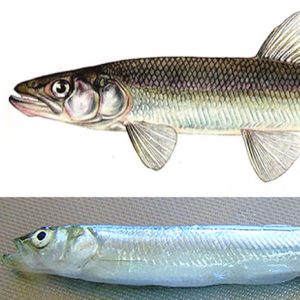calsfoundation@cals.org
Smelts
aka: Osmerids
Smelts belong to the family Osmeridae and order Salmoniformes. There are seven genera and about eleven species. Fishes of the genus Osmerus, to which the rainbow smelt (O. mordax) belongs, include the following: a North Pacific and Arctic species, O. dentex; the European smelt (O. eperlanus) of the Eastern North Atlantic; and the landlocked pygmy smelt (O. spectrum) of eastern Canada and New England, which some authorities suggest is not a valid species. In general, smelts are north circumpolar in geographic distribution, and they occur in marine and freshwater habitats in Asia, Europe, and North America. They date to the Paleocene Epoch (over 55 million years ago). The closest relatives are galaxioid (Protacanthopterygiid) fishes, and the marine argentinoid fishes are their sister group.
The rainbow smelt is a Holarctic species that also occurs in northern Asia, northern Europe, and North America. In Arkansas, it is found only in the Mississippi River, where records include specimens (from south to north) from near Eudora (Chicot County), West Memphis (Crittenden County), and Blytheville (Mississippi County). All of the rainbow smelts from Arkansas were taken in the winter and these were only of small juveniles ranging in length from 34 to 88 mm (1.3 to 3.5 in.). Its status in Arkansas is not known because the species is considered exotic and not applicable according to NatureServe.
Most anadromous (sea-run) populations of O. mordax occur in cool oceans but travel to cool, clear freshwater streams to spawn. However, some populations are landlocked (lacustrine) introductions and are found only in freshwater habitats. Rainbow smelts have also become established through stocking in reservoirs on the Missouri River in North Dakota.
O. mordax are mostly silver, although the dorsal half and body is a steel-blue or greenish gray. The venter is silvery white, and young smelt are translucent. They are slender and elongate fish with an adipose fin and large mouth with well-developed teeth on the jaws and tongue. The lateral line is incomplete, and scales in the lateral series number sixty to seventy-four. Dorsal rays number eight to eleven, there are twelve to seventeen anal rays, and pectoral rays number eleven to fourteen. Anadromous populations are larger than landlocked populations, and the former can reach 305 to 356 mm (12 to 14 in.) in length and weigh 0.1 to 0.2 kg (5 to 8 oz.), whereas the latter are 152 to 254 mm (6 to 10 in.) in length.
Rainbow smelt feed on small crustaceans, fish (especially alewives, Alosa pseudoharengus), dipteran larvae, mysid shrimp, and insects. In some areas, O. mordax is an important forage fish for large predatory fishes, including burbot, perch, trout, and walleye, and birds. Adult rainbow smelt are also important sport and commercial fish. Many are collected in the springtime by seining or dip-netting as they enter tributaries to spawn. They are sometimes eaten as a food fish and are used as bait for salmonids and walleye.
In terms of reproduction, O. mordax gather in large schools, and females spawn at night in gravel in cool streams and lakes in the spring, usually peaking with bimonthly spring tides. This fish tends to avoid waters that have temperatures greater than 16°C (60°F). Once deposited, thousands of eggs sink and adhere to the bottom substrate. The eggs hatch in about ten days, and the maximum life span is reported to be approximately five years. A distinct mortality has been reported during or shortly after spawning runs. Major predators on eggs are fourspine sticklebacks (Apeltes quadratus) and mummichogs (Fundulus heteroclitus).
A great deal of parasites are reported from O. mordax. Most are trematodes, nematodes, and acanthocephalans. None yet have been reported from any specimen of O. mordax from Arkansas.
For additional information:
Buchanan, Thomas M., F. Alan Carter, Sam Henry, and Kenneth Shirley. “Rainbow Smelt, Osmerus mordax (Pisces: Osmeridae), in the Mississippi River of Arkansas and Tennessee.” Southwestern Naturalist 27 (1982): 225‒226.
Boshung, Herbert T., and Richard L. Mayden. Fishes of Alabama. Washington DC: Smithsonian Institution Press, 2004.
Carter, F. Allen. Fishes Collected from the Mississippi River and Adjacent Flood Areas in Arkansas, River Mile 770.0 to River Mile 816.0. Unpublished master’s thesis, Arkansas State University, Jonesboro, 1984.
Douglas, Neil H. The Fishes of Louisiana. Baton Rouge: Claitor’s Publishing Division, 1974.
Etnier, David A., and Wayne C. Starnes. The Fishes of Tennessee. Knoxville: University of Tennessee Press, 1993.
Lantiegne, Jacqueline, and Don E. McAllister. “The Pygmy Smelt, Osmerus spectrum Cope, 1870, a Forgotten Sibling Species of Eastern North American Fish.” Syllogeus 45 (1983):1‒32.
Mayden, Richard L., Frank B. Cross, and O. T. Gorman. “Distributional History of the Rainbow Smelt, Osmerus mordax (Salmoniformes: Osmeridae), in the Mississippi River Basin. Copeia 1987 (1987): 1051‒1054.
McAllister, Don E., B. Parker, and K. V. Couvillion. Osmerus mordax (Mitchell), Rainbow Smelt. In D. S. Lee, et al. Atlas of North American Freshwater Fishes. Raleigh: North Carolina State Museum of Natural History, 1980.
Miller, Rudolph J., and Henry W. Robison. Fishes of Oklahoma. Norman: University of Oklahoma Press, 2004.
NatureServe Explorer: An Online Encyclopedia of Life. http://explorer.natureserve.org (accessed July 6, 2020).
Page, Larry M., and Brooks M. Burr. Peterson Field Guide to Freshwater Fishes of North America North of Mexico. Second Ed. Boston: Houghton Mifflin Harcourt, 2011.
Pennington, C. H., G. J. Dahl, and H. L. Schramm Jr. “Occurrence of the Rainbow Smelt in the Lower Arkansas River.” Journal of the Mississippi Academy of Science 27 (1982): 41‒42.
Pflieger, William L. The Fishes of Missouri. Jefferson City: Missouri Department of Conservation, 1997.
Robison, Henry W., and Thomas M. Buchanan. Fishes of Arkansas. 2nd ed. Fayetteville: University of Arkansas Press, 2020.
Ross, Stephen T. The Inland Fishes of Mississippi. Jackson: University Press of Mississippi, 2001.
Chris T. McAllister
Eastern Oklahoma State
 Percidae
Percidae Science and Technology
Science and Technology Smelts
Smelts 



Comments
No comments on this entry yet.